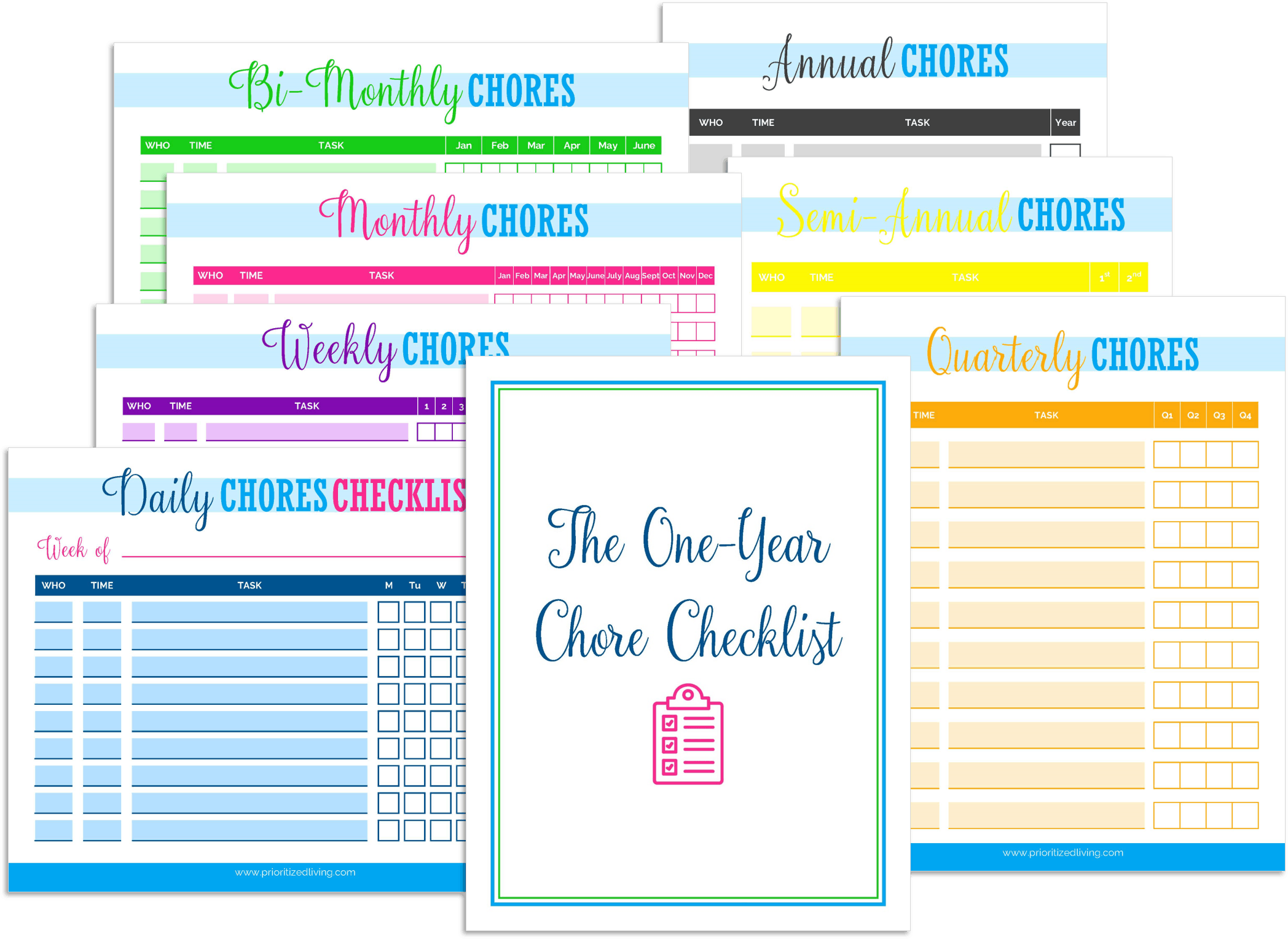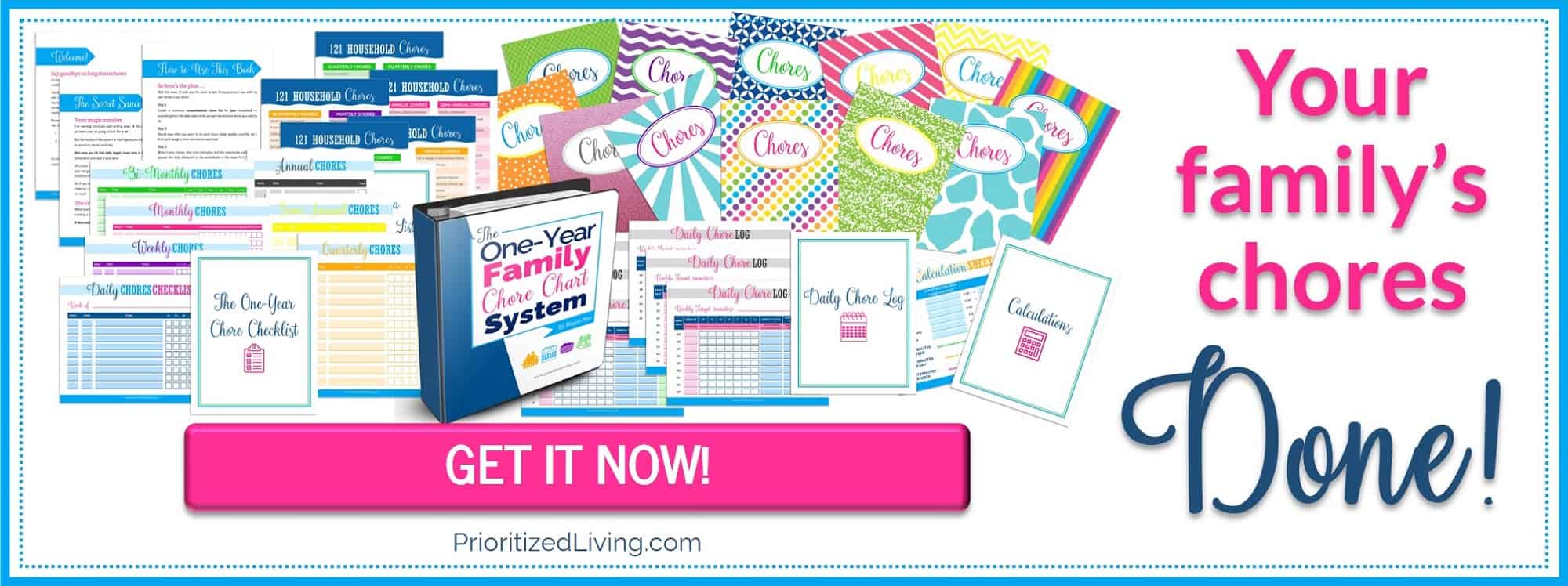Raise your hand if you’ve done an exhausting cleaning marathon in the days leading up to a visit from family and friends.
Or if you’ve wondered when the last time was that you cleaned the bathtub, refilled your washer fluid, or mopped the floor that you’re pretty sure is supposed to be three shades lighter.
Or if you just can not seem to get everyone in your home on board with what needs to be done when and by whom.
Sure, you could hold out for spring cleaning. But that just seems like a great way to turn beautiful spring days into drudgery. And what about the dirt and mess the rest of the year?
It’s time to stop thinking that you need to choose between succumbing to an endless chore list and accepting the reality of a messy home!
There’s a third option — strategically distributing your household chores throughout the year so you can enjoy a clean, organized home year-round . . . without nagging, complicated systems, and that massive time-suck.
Fortunately, it’s incredibly simple to customize a fool-proof, year-long family chore chart schedule and system that will beautify your home and keep it that way for good!
Here’s how . . .
1. Make a list of everything.

The objective of Step 1 is to create a comprehensive chore list for every household task your family needs to complete in a typical year. We’re talking everything from stacking the dishes each day to tossing out expired medication once a year.
Scroll down to find a few dozen typical chores to get you started. Or, better yet, grab a FREE, downloadable list of 121 household chores that gets you 90% of the way there. Just customize as needed for your family!
2. Determine your chore frequency.
Once you’ve got your master list, it’s time to assign a frequency to each and every task.
Will you do a given chore once a month? Twice a year? Every week?
Be realistic! If you’d like to mop your floor every week but can’t seriously see yourself doing it more than once a month, target just 12 moppings a year.
Split your chore list into tasks that should occur daily, weekly, bi-monthly, monthly, quarterly, semi-annually, and annually.
3. Now give every task a time estimate.
Think about this: How long do you reasonably expect each chore to take?
Keep in mind who’s responsible for a given task. So scrubbing your master bathroom yourself might require half the time your 12-year-old takes to clean up hers.
Warning: Do not skip this step!
It’s essential that you know precisely how much time you’ll need to set aside for chores so you can compute your family’s “magic number” in just a moment.
Plus, having an estimate is intensely helpful when you’ve got just 5 or 10 minutes to complete a task. You can simply scan your list for a quick chore and knock it out in the limited time you have.
Put down your best guess for how many minutes every chore on your list will need to be finished. Take into consideration any time required for rounding up supplies (like cleaners and brushes) and putting them away
Don’t worry at this point about under- or overestimating. After living with your finished chore plan for a few weeks, you’ll have a better sense of how much time you truly need. So, you can easily go back and revise your plan with that new information.
4. Add it all up.
It’s time to calculate your total chore time for the year. Brace yourself! This is going to be a big number. But we’ll break it into manageable chunks in the next step.
Keep in mind that you’ll want to count chores differently depending on how frequently you complete them.
So you’ll count a 15-minute annual chore just once. But a 10-minute quarterly chore translates to 40 minutes for the whole year. And a 5-minute monthly task is 60 minutes a year.
A spreadsheet can make this process much easier than a calculator or pencil and paper. But the simplest way to compute your annual target is to use a done-for-you chore calculator and chore chart system! GET YOURS HERE!
5. Compute your daily chore time.
So what’s your magic number?
It’s the number of minutes your family should spend on chores each day to get each and every chore completed — the desired number of times — for an entire year.
Some basic division will get your scary-big annual chore time down to a manageable daily chore target. Just divide that annual figure by 365 (or 366 for a leap year) to calculate how many minutes of chores you’ll want to hit each day.
So, for instance, suppose your annual chore target from Step 4 comes out to 20,075 minutes. For a 365-day year, you’ll need 55 minutes each day to complete all your chores.
Here’s the beauty of it: After you hit your daily chore total, you are DONE.
Instead of worrying about what you’ve forgotten or whether there’s some other chore you should be doing, you can enjoy peace of mind and actual time to do other, more fulfilling things with your life!
6. Divide & conquer!
Okay, if you’re thinking that 55 minutes per day (or whatever target number you’ve calculated) sounds high, remember his important fact:
Your daily chore target isn’t just for you; it’s a target for your entire household.

It’s up to you.
Just make sure from the outset that each family member understands how much time they’re required to spend on chores each day.
Once everyone’s in on the game plan, press play and watch your system manage itself. There’s no more guessing what needs to be done, realizing that it’s been too long since you’ve done some chore, or having to spell out for every member of your household who needs to do what when.
Everybody takes a look at the list, picks a set of tasks they’ve been assigned, and works until their personal chore target is met.
With your chore chart plan in place, you can take the anguish — and hopefully any nagging you might otherwise do! — out of family chores.
7. Stay on track.
So what’s the best way to set up your chore system and easily track what’s done (and what remains)?
It’s The One-Year Family Chore Chart System — a comprehensive resource that includes printable chore charts, tracking sheets, a step-by-step calculator, and easy-to-follow directions. So creating your own family chore system is a snap!
This done-for-you system offers everything you need to create a comprehensive chore list, compute your family’s magic number, and get things done . . . so you can enjoy your life!
No more nagging. No more pulling your hair out over a mess that you see (but your kids and spouse don’t!). No more marathon cleaning sessions before guests arrive.
Just a clean, organized home with minimal upkeep every day of the year.
Ready to Get Started?
Remember: The first step is making that master list of your household chores. And that task can sound like a major chore all by itself!
So I’ve put together a starter list of typical household chores to save you some time. Brainstorm your own additional tasks and customize to your needs.
Keep in mind that the frequency with which you tackle each of these chores depends entirely on your family and your lifestyle. So a once-a-week approach to laundry might not work if you’ve got a bigger family, a lot of sports practices, or a new baby at home. Adjust as needed!
Daily Chores
- Stack the dishwasher.
- Wipe the table and counters after dinner.
- Put away toys and books.
- Sort through the day’s mail.
Weekly Chores
- Wash a load of laundry.
- Plan next week’s menu.
- Water your plants.
- Taking the trash and recycling out for pick-up.
- Back up your computer files.
Bi-Monthly Chores
- Launder the sheets & towels.
- Dust bedrooms.
- Clean the bathrooms.
Monthly Chores
- Mop the kitchen floor.
- Wash bathroom rugs.
- Sanitize cell phones.
Quarterly Chores
- Vacuum & spot-clean couches and chairs.
- Scrub the fridge interior.
- Sharpen knives.
- Wash pillows.
- Changing furnace filters.
Semi-Annual Chores
- Clean cabinet exteriors.
- Dust banisters and railings.
- Sanitize door handles.
- Wash comforters.
- Replace smoke detector batteries.
Annual Chores
- Throw out expired toiletries & medicines.
- Dust baseboards.
- Rotate mattresses.
- Perform annual maintenance on lawn mowers, snow blowers, etc.
- Sweep out and washing the garage floor.
Want a master list of 121 chores? Download your FREE MEGA FAMILY CHORE LIST!
Feeling overwhelmed with balancing your life and keeping your home tidy? Stop wondering how to keep your house clean. With a simple system in place, you can list, assign, and complete all your family’s chores. And you can finally have that lovely home and the time to do the things you truly enjoy!
Have you instituted a family chore schedule? How has it changed the way you tackle household chores? What was the biggest challenge in putting your plan into motion?























Leave a Reply